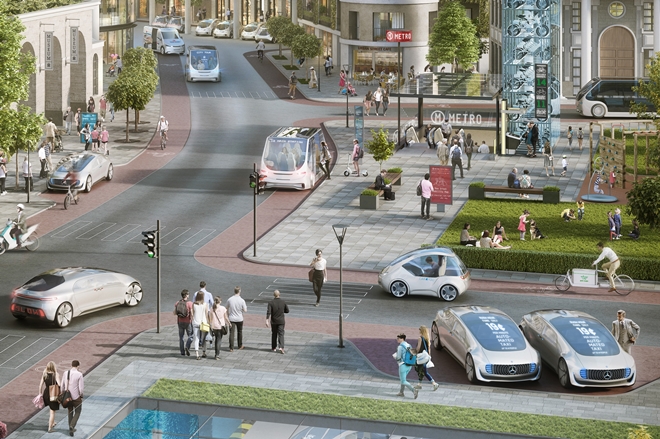By: Arpit Mahendra
Every 25 seconds or so, someone loses their life in a traffic accident somewhere in the world. 1.2 million traffic fatalities take place every year and about 90 % of these accidents happen due to human error. Around one-third of the traffic congestion in cities is caused by people looking for parking spots.
These are just some of the massive problems the world is facing today due to the rapid pace of urbanisation. With every passing day, more and more people around the globe are moving to cities in hope of economic development.
Such is the pace of this movement that by 2050, the number of people living in large cities will increase two-folds to more than six billion. With limited space for expansion and most megacities already struggling with the present population, the future seems quite challenging.
One of the areas to be significantly affected by this people movement is mobility. Congestion will become worse, air quality will deteriorate further, the number of accidents will go up and stress levels will go even higher.
All this is going to have an adverse effect on the society and our future generations. In the US alone, drivers in 10 cities with the densest traffic spent around 42 hours in traffic jams, resulting in a loss of $ 121 billion in time and fuel!

The only solution to this problem is to have a smart mobility system, which can interact with people, vehicles, and infrastructure, thereby helping avoid the above-mentioned problems. Bosch recently conducted the Mobility Experience 2017 in Boxberg, Germany, where it showcased various technologies that can help improve the quality of life in cities.
Smart & Autonomous
The key areas that will transform urban mobility include autonomous driving, small electric cars, and ride-sharing. While it may seem that some of these solutions may not be fit for India right now, the reality is quite different.
The future of driving is going to be connected and assisted, which means that in a couple of decades we might just stop driving altogether. This may sound disappointing but in the interest of safety, this seems to be the right path.

Bosch is presently working on a number of assistance systems that can reduce the stress for drivers and enhance safety. The need for such technologies is higher in India since 15 to 35 deaths occur for every 100,000 road users in Jaipur, compared to the 3 to 5 deaths in Berlin and Tokyo.
One of the systems that I found particularly interesting and suitable for India was the Automatic Emergency Braking (AEB), which can detect an imminent collision and apply brakes automatically, avoiding the accident or limiting the damage.
The system developed by Bosch can also detect cyclists/ people in fog or conditions with limited visibility. This system could save many lives, especially in the Northern India, which gets enveloped in blinding fog during winter, leading to a higher rate of accidents.

Automated driving was one the highlights of the event and the vehicle we witnessed it in was based on a Tesla Model S. Around 1.3 km of cable, 1,400 hours of work and 50 new components lend the car with a high level of autonomous capability in the real world.
A human-machine interface (HMI) concept developed by Bosch can identify its drivers and automatically load the appropriate user profile. The HMI informs the driver when a stretch of the road is available for automated driving.
In order to ensure that drivers do not fall asleep when the vehicle is driving on its own an interior camera continuously monitors the driver’s eye movements. While experiencing this vehicle, the driver shut his eyes and quickly the system gave out audio warnings.
When the driver did not respond, the car looked for the nearest possible safe spot to stop and parked itself there. In real-world, the car in such case can connect with emergency services as such a situation could mean the driver is facing some medical emergency. Having a simpler form of this system could play a great role in making highways safer for India as it might be able to alert drivers of imminent risks and avoid accidents.

Connected parking is one more technology that makes great sense for India. Cars that can not only park themselves but can also communicate with other cars and infrastructure to find out parking spaces will have a tremendous positive impact on the traffic flow.
This will be in addition to the time and effort it will help save for people. There are already cars costing around Rs 15 lakh that can park themselves so it’s only a matter of time before suppliers such as Bosch achieve higher economies of scale and trickle the technology down to smaller cars.
Electric Cars
By now it’s clear that electric cars are the future and Bosch, being the world’s largest automotive supplier is working on many technologies that are pushing the boundaries of efficiency and range. Small electric vehicles are a focus area for Bosch and understandably so as they make great sense for congested cities.
These also include electric two-wheelers as around 100 million light electric vehicles will be sold globally by 2020. These also make great sense for India but someone needs to figure out the cost part, which continues to be high as of now.

Electric two-wheelers in India use lead-acid batteries right now and hence have range and performance issues. Lithium-ion batteries with an integrated and smart system as shown by Bosch can greatly enhance the capability of such scooters but would push the cost further up. This is the part where vehicle makers and suppliers need to work in tandem with the Government so that the masses see enough appeal in electric two-wheelers.
The systems shown by Bosch though are scalable, which makes it possible to produce different versions quickly at a low-cost for vehicle manufacturers.

For the growth of autonomous driving too, small electric cars seem to be a perfect fit. Ride-sharing will gain popularity over the next few years and small electric cars can easily be used for this purpos
Their small size will make it easier to navigate congested streets and lower cost will quicken adoption by operators or city authorities. This may seem far but some cities in Europe could have an autonomous ride-sharing service by 2025 or sooner.
Connectivity, the backbone for future mobility
While we’ve gone through autonomous cars and electric vehicles by now, the most critical part for these vehicles to operate as desired is connectivity. Even our regular cars these days are well-connected to our smartphone.
Autonomous cars, however, will need to be connected with almost everything in the environment around them including other vehicles, traffic signals, emergency services and more.
Autonomous cars will need to process a gigantic amount of data to operate safely, as high as one gigabyte every second! This data itself will hold tremendous value since comp
anies will be able to collate this data to make systems more powerful or draw patterns from certain events to chart out a more efficient way of functioning.

There are great benefits of autonomous technology apart from the usual ones we are mostly aware of. As everything around us goes digital connected cars will gain importance as they’ll be able to communicate with appliances in your home as well.
Imagine being driven back from work and as you approach your home, the air-conditioning is switched on to cool down the rooms and the TV already starts playing your favourite sport. These possibilities are a fraction of the potential autonomous driving holds for the future.

There is a challenge though, especially for India for all this connectivity to work and that is the availability of internet. While internet availability in developed countries is good, India still has a long way to go before our infrastructure can support autonomous driving.
Traffic sense is another major issue and will take a fair bit of time to improve. Smaller autonomous systems then are going to be the bridge between the present and future mobility for countries such as India for now.
Conclusion
Technology is developing rapidly today and future mobility is going to be much smarter, efficient and safer than the present. The shift to autonomous cars is happening quicker than we can imagine and certain countries such as Germany, Sweden, Japan and the US are leading this shift.
As norms across the world demand lower emissions and higher safety, autonomous cars with electric powertrains will witness mass adoption, primarily in the car-sharing model and not the personal ownership model.

From India’s perspective, fully-autonomous driving might still be a long way off but parts of it and certain systems such as AEB hold immense potential to increase safety and the flow of traffic.
There are other systems too such as a lane guidance system that can work even in the absence of lane marking.There were more technologies that we were shown and made to experience but in the interest of time and space let’s keep it limited to the future of driving in this article.
While technology will continue to evolve at a rapid pace, I feel a bit sad as future cars will not be as engaging and exciting to drive as the present ones. The way we associate cars with the character of a person will be lost as self-driving cars with standard functions will take over.
However, a part of me feels happy too since millions of lives will be saved and billions will spend lesser time in traffic while breathing cleaner air.
These are just some of the massive problems the world is facing today due to the rapid pace of urbanisation. With every passing day, more and more people around the globe are moving to cities in hope of economic development.
Such is the pace of this movement that by 2050, the number of people living in large cities will increase two-folds to more than six billion. With limited space for expansion and most megacities already struggling with the present population, the future seems quite challenging.
One of the areas to be significantly affected by this people movement is mobility. Congestion will become worse, air quality will deteriorate further, the number of accidents will go up and stress levels will go even higher.
All this is going to have an adverse effect on the society and our future generations. In the US alone, drivers in 10 cities with the densest traffic spent around 42 hours in traffic jams, resulting in a loss of $ 121 billion in time and fuel!

The only solution to this problem is to have a smart mobility system, which can interact with people, vehicles, and infrastructure, thereby helping avoid the above-mentioned problems. Bosch recently conducted the Mobility Experience 2017 in Boxberg, Germany, where it showcased various technologies that can help improve the quality of life in cities.
Smart & Autonomous
The key areas that will transform urban mobility include autonomous driving, small electric cars, and ride-sharing. While it may seem that some of these solutions may not be fit for India right now, the reality is quite different.
The future of driving is going to be connected and assisted, which means that in a couple of decades we might just stop driving altogether. This may sound disappointing but in the interest of safety, this seems to be the right path.

Bosch is presently working on a number of assistance systems that can reduce the stress for drivers and enhance safety. The need for such technologies is higher in India since 15 to 35 deaths occur for every 100,000 road users in Jaipur, compared to the 3 to 5 deaths in Berlin and Tokyo.
One of the systems that I found particularly interesting and suitable for India was the Automatic Emergency Braking (AEB), which can detect an imminent collision and apply brakes automatically, avoiding the accident or limiting the damage.
The system developed by Bosch can also detect cyclists/ people in fog or conditions with limited visibility. This system could save many lives, especially in the Northern India, which gets enveloped in blinding fog during winter, leading to a higher rate of accidents.

Automated driving was one the highlights of the event and the vehicle we witnessed it in was based on a Tesla Model S. Around 1.3 km of cable, 1,400 hours of work and 50 new components lend the car with a high level of autonomous capability in the real world.
A human-machine interface (HMI) concept developed by Bosch can identify its drivers and automatically load the appropriate user profile. The HMI informs the driver when a stretch of the road is available for automated driving.
In order to ensure that drivers do not fall asleep when the vehicle is driving on its own an interior camera continuously monitors the driver’s eye movements. While experiencing this vehicle, the driver shut his eyes and quickly the system gave out audio warnings.
When the driver did not respond, the car looked for the nearest possible safe spot to stop and parked itself there. In real-world, the car in such case can connect with emergency services as such a situation could mean the driver is facing some medical emergency. Having a simpler form of this system could play a great role in making highways safer for India as it might be able to alert drivers of imminent risks and avoid accidents.

Connected parking is one more technology that makes great sense for India. Cars that can not only park themselves but can also communicate with other cars and infrastructure to find out parking spaces will have a tremendous positive impact on the traffic flow.
This will be in addition to the time and effort it will help save for people. There are already cars costing around Rs 15 lakh that can park themselves so it’s only a matter of time before suppliers such as Bosch achieve higher economies of scale and trickle the technology down to smaller cars.
Electric Cars
By now it’s clear that electric cars are the future and Bosch, being the world’s largest automotive supplier is working on many technologies that are pushing the boundaries of efficiency and range. Small electric vehicles are a focus area for Bosch and understandably so as they make great sense for congested cities.
These also include electric two-wheelers as around 100 million light electric vehicles will be sold globally by 2020. These also make great sense for India but someone needs to figure out the cost part, which continues to be high as of now.

Electric two-wheelers in India use lead-acid batteries right now and hence have range and performance issues. Lithium-ion batteries with an integrated and smart system as shown by Bosch can greatly enhance the capability of such scooters but would push the cost further up. This is the part where vehicle makers and suppliers need to work in tandem with the Government so that the masses see enough appeal in electric two-wheelers.
The systems shown by Bosch though are scalable, which makes it possible to produce different versions quickly at a low-cost for vehicle manufacturers.

For the growth of autonomous driving too, small electric cars seem to be a perfect fit. Ride-sharing will gain popularity over the next few years and small electric cars can easily be used for this purpos
Their small size will make it easier to navigate congested streets and lower cost will quicken adoption by operators or city authorities. This may seem far but some cities in Europe could have an autonomous ride-sharing service by 2025 or sooner.
Connectivity, the backbone for future mobility
While we’ve gone through autonomous cars and electric vehicles by now, the most critical part for these vehicles to operate as desired is connectivity. Even our regular cars these days are well-connected to our smartphone.
Autonomous cars, however, will need to be connected with almost everything in the environment around them including other vehicles, traffic signals, emergency services and more.
Autonomous cars will need to process a gigantic amount of data to operate safely, as high as one gigabyte every second! This data itself will hold tremendous value since comp
anies will be able to collate this data to make systems more powerful or draw patterns from certain events to chart out a more efficient way of functioning.

There are great benefits of autonomous technology apart from the usual ones we are mostly aware of. As everything around us goes digital connected cars will gain importance as they’ll be able to communicate with appliances in your home as well.
Imagine being driven back from work and as you approach your home, the air-conditioning is switched on to cool down the rooms and the TV already starts playing your favourite sport. These possibilities are a fraction of the potential autonomous driving holds for the future.

There is a challenge though, especially for India for all this connectivity to work and that is the availability of internet. While internet availability in developed countries is good, India still has a long way to go before our infrastructure can support autonomous driving.
Traffic sense is another major issue and will take a fair bit of time to improve. Smaller autonomous systems then are going to be the bridge between the present and future mobility for countries such as India for now.
Conclusion
Technology is developing rapidly today and future mobility is going to be much smarter, efficient and safer than the present. The shift to autonomous cars is happening quicker than we can imagine and certain countries such as Germany, Sweden, Japan and the US are leading this shift.
As norms across the world demand lower emissions and higher safety, autonomous cars with electric powertrains will witness mass adoption, primarily in the car-sharing model and not the personal ownership model.

From India’s perspective, fully-autonomous driving might still be a long way off but parts of it and certain systems such as AEB hold immense potential to increase safety and the flow of traffic.
There are other systems too such as a lane guidance system that can work even in the absence of lane marking.There were more technologies that we were shown and made to experience but in the interest of time and space let’s keep it limited to the future of driving in this article.
While technology will continue to evolve at a rapid pace, I feel a bit sad as future cars will not be as engaging and exciting to drive as the present ones. The way we associate cars with the character of a person will be lost as self-driving cars with standard functions will take over.
However, a part of me feels happy too since millions of lives will be saved and billions will spend lesser time in traffic while breathing cleaner air.















